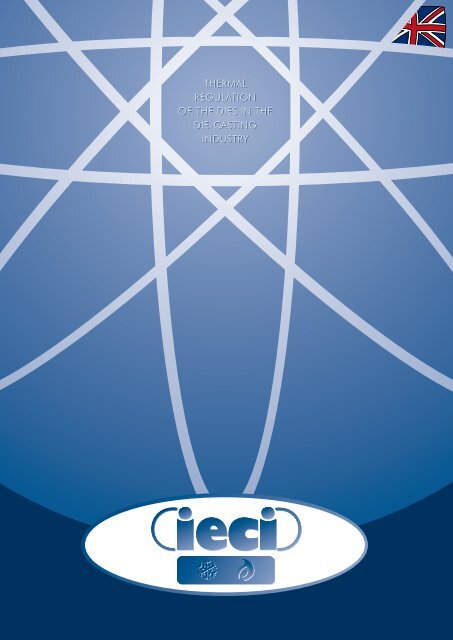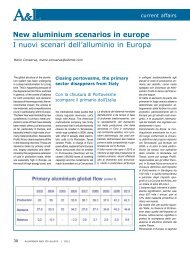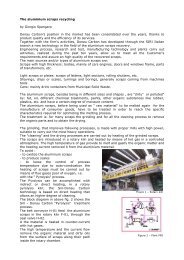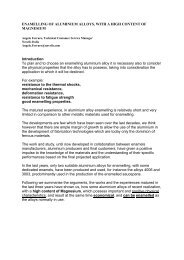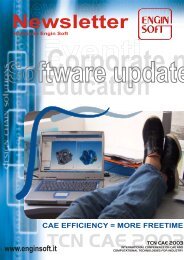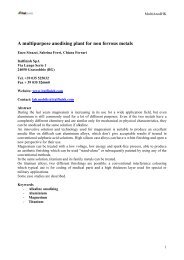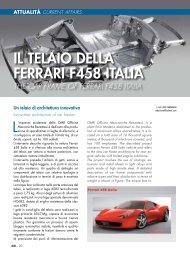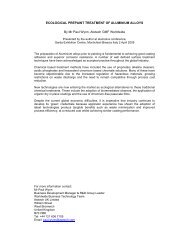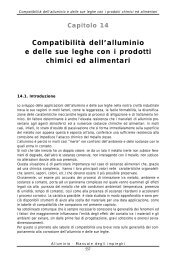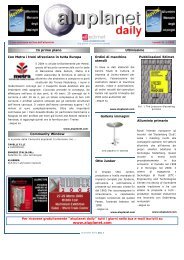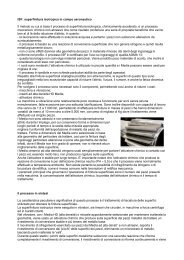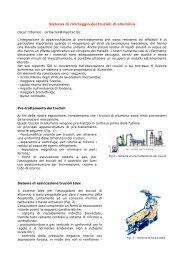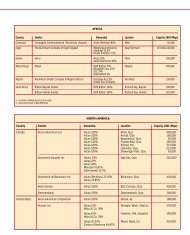thermal regulation of the dies in the die-casting industry ... - Aluplanet
thermal regulation of the dies in the die-casting industry ... - Aluplanet
thermal regulation of the dies in the die-casting industry ... - Aluplanet
You also want an ePaper? Increase the reach of your titles
YUMPU automatically turns print PDFs into web optimized ePapers that Google loves.
THERMAL<br />
REGULATION<br />
OF THE DIES IN THE<br />
DIE-CASTING<br />
INDUSTRY
CONTROL OF THE DIE TEMPERATURE<br />
THE STATE OF TECHNOLOGY<br />
THE PRODUCTS<br />
COMPANY PROFILE<br />
IECI<br />
INDUSTRIAL THERMAL REGULATORS<br />
Via P.L. Nervi, 13<br />
25050 PASSIRANO (BRESCIA) - ITALY<br />
Tel. +39 - 030 68 50 370 r.a.<br />
Fax +39 - 030 68 50 511<br />
e-mail ieci@iol.it<br />
www.iecionl<strong>in</strong>e.com
CONTROL<br />
OF<br />
THE DIE<br />
TEMPERATURE
In <strong>the</strong> cast<strong>in</strong>g, <strong>the</strong> temperature <strong>of</strong> <strong>the</strong> <strong>die</strong> has<br />
a notable <strong>in</strong>fluence on <strong>the</strong> quality <strong>of</strong> <strong>the</strong> pieces<br />
and on <strong>the</strong> work cycle.<br />
Work<strong>in</strong>g with a <strong>die</strong> temperature which is too<br />
low, you can encounter <strong>the</strong> follow<strong>in</strong>g problems:<br />
• Rapid degrad<strong>in</strong>g <strong>of</strong> <strong>the</strong> <strong>die</strong>;<br />
• Difficult expulsion;<br />
• Contraction <strong>of</strong> <strong>the</strong> piece around <strong>the</strong> p<strong>in</strong>s;<br />
• Weld<strong>in</strong>g between <strong>the</strong> metal and <strong>the</strong> <strong>die</strong>;<br />
• Reduction <strong>in</strong> <strong>the</strong> efficiency <strong>of</strong> <strong>the</strong> lubroseparators;<br />
• Dimensional <strong>in</strong>stability;<br />
• Incomplete fill<strong>in</strong>g.<br />
Operat<strong>in</strong>g <strong>in</strong> <strong>the</strong> o<strong>the</strong>r way, with a <strong>die</strong><br />
temperature which is too high can result <strong>in</strong> <strong>the</strong><br />
follow<strong>in</strong>g problems:<br />
• Difficult expulsion <strong>of</strong> <strong>the</strong> cast (deformations,<br />
seams);<br />
• Rapid degrad<strong>in</strong>g <strong>of</strong> <strong>the</strong> lubro-separant;<br />
• Leng<strong>the</strong>n<strong>in</strong>g <strong>of</strong> <strong>the</strong> cycle time;<br />
• Dimensional piece <strong>in</strong>stability;<br />
• Air bubble formation;<br />
• Presence <strong>of</strong> withdrawal porousness<br />
and cavities;<br />
• Increased wear <strong>of</strong> <strong>the</strong> <strong>die</strong>.<br />
It seems clear that <strong>the</strong> correct check<strong>in</strong>g <strong>of</strong> <strong>the</strong><br />
<strong>die</strong> temperature, takes on a vital importance<br />
to atta<strong>in</strong> a high and constant production quality<br />
alongside an optimization <strong>of</strong> <strong>the</strong> productive<br />
cycle.<br />
The <strong><strong>the</strong>rmal</strong> regulators are electro-mechanical<br />
pieces <strong>of</strong> equipment which have <strong>the</strong> role <strong>of</strong><br />
<strong>the</strong>rmically regulat<strong>in</strong>g <strong>the</strong> <strong><strong>die</strong>s</strong> used dur<strong>in</strong>g<br />
<strong>the</strong> <strong>die</strong>-cast<strong>in</strong>g process.<br />
The <strong><strong>the</strong>rmal</strong> <strong>regulation</strong> comes by heat<strong>in</strong>g<br />
and/or cool<strong>in</strong>g a fliud (dia<strong>the</strong>rmic oil or<br />
pressurised water), which is <strong>the</strong>n sent, by means<br />
<strong>of</strong> an electric pump, <strong>in</strong>side <strong>the</strong> channels<br />
extracted <strong>in</strong> <strong>the</strong> <strong>die</strong>; <strong>the</strong> heat transmission to<br />
<strong>the</strong> cast surface <strong>the</strong>n makes for <strong>the</strong> convection<br />
between <strong>the</strong> fluid and <strong>the</strong> channel surfaces<br />
and for conduction through <strong>the</strong> material <strong>of</strong> <strong>the</strong><br />
<strong>die</strong> itself.<br />
With <strong>the</strong> use <strong>of</strong> <strong><strong>the</strong>rmal</strong> <strong>regulation</strong> exchange,<br />
you are able to highlight <strong>the</strong> ma<strong>in</strong> advantages<br />
<strong>in</strong>dicated <strong>in</strong> <strong>the</strong> follow<strong>in</strong>g four po<strong>in</strong>ts:<br />
1) IMPROVEMENT IN THE MECHANICAL<br />
CHARACTERISTICS AND OF THE CAST<br />
HOLDING;<br />
2) POSSIBILITY OF INCREASING THE<br />
PRODUCTIVITY OF THE PRESSES<br />
THROUGH THE REDUCTION OF THE<br />
CYCLE TIME ;<br />
3) INCREASE IN DIE LIFE-SPAN;<br />
6<br />
4) REDUCTION IN INITIAL REJECTS.
THERMAL REGULATORS<br />
FOR IMPROVING<br />
THE QUALITY OF THE<br />
CASTING<br />
The mechanical characteristics <strong>of</strong> <strong>die</strong>-cast<strong>in</strong>g<br />
are closely correlated to <strong>the</strong> structural<br />
morphology <strong>of</strong> <strong>the</strong> alloy and its granulometry.<br />
In particular, one encounters an improvement<br />
<strong>of</strong> <strong>the</strong> follow<strong>in</strong>g values:<br />
elongation %,<br />
mechanical resistance to traction,<br />
hardness,<br />
with <strong>the</strong> <strong>in</strong>crease <strong>of</strong> <strong>the</strong> number <strong>of</strong> gra<strong>in</strong>s per<br />
unit <strong>of</strong> volume, that is with a f<strong>in</strong>e crystall<strong>in</strong>e<br />
structure.<br />
The size <strong>of</strong> <strong>the</strong> crystals <strong>in</strong> <strong>die</strong>-cast<strong>in</strong>g is<br />
undoubtedly l<strong>in</strong>ked to <strong>the</strong> local cool<strong>in</strong>g time <strong>of</strong><br />
<strong>the</strong> cast<strong>in</strong>g:<br />
• Short cool<strong>in</strong>g time (small thicknesses) =><br />
FINE STRUCTURE => improved mechanical and<br />
seal<strong>in</strong>g characteristics;<br />
• Improved cool<strong>in</strong>g time (large thicknesses)<br />
=> COURSE STRUCTURE => limited mechanical<br />
and seal<strong>in</strong>g characteristics.<br />
7<br />
Utilis<strong>in</strong>g <strong><strong>the</strong>rmal</strong> regulators, a very high<br />
cool<strong>in</strong>g velocity is obta<strong>in</strong>ed and <strong>the</strong>refore <strong>the</strong><br />
mechanical and seal<strong>in</strong>g properties <strong>of</strong> <strong>the</strong> part<br />
are improved.<br />
With parts that have different thicknesses, it is<br />
possible to adjust <strong>the</strong> mechanical and seal<strong>in</strong>g<br />
properties, mak<strong>in</strong>g <strong>the</strong> solidification time<br />
constant <strong>in</strong> <strong>the</strong> various zones <strong>of</strong> <strong>the</strong> cast<strong>in</strong>g,<br />
heat<strong>in</strong>g <strong>the</strong> zones that are too cold (<strong>of</strong> small<br />
thickness) and cool<strong>in</strong>g <strong>the</strong> zones that are too<br />
hot (<strong>of</strong> large thickness).
THERMAL REGULATORS<br />
FOR INCREASING<br />
PRODUCTIVITY<br />
With <strong>the</strong> use <strong>of</strong> <strong><strong>the</strong>rmal</strong> regulators it is<br />
possible to obta<strong>in</strong> an improvement <strong>of</strong><br />
company productivity.<br />
Increas<strong>in</strong>g <strong>the</strong> cast<strong>in</strong>gs/h we have an<br />
<strong>in</strong>crement <strong>of</strong> <strong>the</strong> quantity <strong>of</strong> heat transferred<br />
from <strong>the</strong> alloy to <strong>the</strong> pr<strong>in</strong>ter surface (for <strong>the</strong><br />
alloy UNI 5076 Q= 798 Kj/Kg), from which<br />
an <strong>in</strong>crease <strong>of</strong> <strong>the</strong> temperature <strong>of</strong> <strong>the</strong><br />
impression is produced, lead<strong>in</strong>g to an <strong>in</strong>crease<br />
<strong>in</strong> <strong>the</strong> solidification time.<br />
With <strong>the</strong> help <strong>of</strong> <strong><strong>the</strong>rmal</strong> <strong>regulation</strong> systems<br />
it is possible to ma<strong>in</strong>ta<strong>in</strong> a high number <strong>of</strong><br />
moulds as this <strong><strong>the</strong>rmal</strong> <strong>in</strong>crement is elim<strong>in</strong>ated,<br />
<strong>in</strong>creas<strong>in</strong>g <strong>the</strong> cool<strong>in</strong>g.<br />
THERMAL REGULATORS<br />
FOR INCREASING THE<br />
LIFE OF THE DIE<br />
The <strong><strong>die</strong>s</strong> that are normally used <strong>in</strong> <strong>the</strong> <strong>die</strong>cast<strong>in</strong>g<br />
process have physical and mechanical<br />
characteristics which var y with <strong>the</strong> temperature,<br />
as <strong>in</strong> <strong>the</strong> follow<strong>in</strong>g graph.<br />
Curve show<strong>in</strong>g heat resistance <strong>of</strong> steel<br />
for <strong><strong>die</strong>s</strong> “W300”<br />
Rp=Resistence and limit <strong>of</strong> weaken<strong>in</strong>g 0.2 <strong>in</strong> N/mm 2<br />
1800<br />
1600<br />
1400<br />
1200<br />
1000<br />
800<br />
600<br />
400<br />
200<br />
0<br />
20<br />
Rm<br />
Rp0,2<br />
Z<br />
200 400 600<br />
Test temperature <strong>in</strong> C<br />
80<br />
60<br />
40<br />
20<br />
0<br />
Z=Contraction <strong>in</strong> %<br />
8<br />
Rm= mechanical attraction resistance
With <strong><strong>the</strong>rmal</strong> regulators it is possible to obta<strong>in</strong><br />
suitable pre-heat<strong>in</strong>g <strong>of</strong> <strong>the</strong> <strong>die</strong> <strong>in</strong> order to:<br />
• Surpass <strong>the</strong> Fragile/Ductile transition<br />
temperature <strong>of</strong> <strong>the</strong> steel (around 150 C),<br />
under which <strong>the</strong>re is a high probability that<br />
structural damage due to <strong><strong>the</strong>rmal</strong> fatigue will<br />
be brought to light.<br />
• Reduce <strong>the</strong> <strong><strong>the</strong>rmal</strong> gra<strong>die</strong>nt between <strong>the</strong><br />
<strong>die</strong> and <strong>the</strong> molten metal <strong>in</strong> both <strong>the</strong> prepress<strong>in</strong>g<br />
phase and dur<strong>in</strong>g mach<strong>in</strong>e standstill,<br />
notably limit<strong>in</strong>g <strong>the</strong> <strong><strong>the</strong>rmal</strong> tensions <strong>in</strong> <strong>the</strong><br />
steel.<br />
Operat<strong>in</strong>g <strong>in</strong> <strong>the</strong> way described it is possible<br />
to obta<strong>in</strong> an <strong>in</strong>crement <strong>of</strong> <strong>die</strong> duration <strong>of</strong> even<br />
27-30% (*).<br />
THERMAL REGULATORS<br />
FOR DECREASING INITIAL<br />
REJECTS<br />
The heat<strong>in</strong>g <strong>of</strong> <strong>the</strong> <strong>die</strong> at <strong>the</strong> beg<strong>in</strong>n<strong>in</strong>g <strong>of</strong> <strong>the</strong><br />
cycle and <strong>the</strong>refore dur<strong>in</strong>g mach<strong>in</strong>e standstill,<br />
as well as <strong>in</strong>creas<strong>in</strong>g <strong>the</strong> life <strong>of</strong> <strong>the</strong> <strong><strong>die</strong>s</strong> by<br />
dim<strong>in</strong>ish<strong>in</strong>g <strong><strong>the</strong>rmal</strong> shocks, allows <strong>the</strong> reduction<br />
<strong>of</strong> <strong>the</strong> number <strong>of</strong> shots necessary to br<strong>in</strong>g <strong>the</strong><br />
figure to temperature.<br />
9<br />
Consequently, it has been verified that <strong>in</strong> some<br />
cases <strong>the</strong> reduction <strong>of</strong> rejects has reached<br />
values <strong>of</strong> approximately 65% (*).
THE STATE<br />
OF<br />
TECHNOLOGY
Today’s technology provides <strong>the</strong> user with a<br />
choice <strong>of</strong> <strong><strong>the</strong>rmal</strong> regulators which are generally<br />
subdivided accord<strong>in</strong>g to <strong>the</strong> type <strong>of</strong> <strong><strong>the</strong>rmal</strong><br />
carrier fluid used (dia<strong>the</strong>rmic oil or water)<br />
and <strong>the</strong> type <strong>of</strong> heat<strong>in</strong>g system used (electrical<br />
energy or gas).<br />
The optimum characteristics for a <strong><strong>the</strong>rmal</strong><br />
carrier fluid are:<br />
· High boil<strong>in</strong>g po<strong>in</strong>t;<br />
· High <strong><strong>the</strong>rmal</strong> conductivity;<br />
· High po<strong>in</strong>t <strong>of</strong> <strong>in</strong>flammability (for oily fluids);<br />
· Inoxibility;<br />
· Non corrosiveness;<br />
· Non toxicity.<br />
Normally, water or dia<strong>the</strong>rmic oils are used<br />
as <strong><strong>the</strong>rmal</strong> regulat<strong>in</strong>g fluids.<br />
Water has a coefficient <strong>of</strong> heat transmission<br />
by convection and conduction which is about<br />
double that <strong>of</strong> oil.<br />
However, on <strong>the</strong> negative side it has a low<br />
boil<strong>in</strong>g po<strong>in</strong>t, is susceptible to form<strong>in</strong>g calcareous<br />
deposits and to trigger<strong>in</strong>g corrosive<br />
phenomena.<br />
These three problems can be solved by pressuris<strong>in</strong>g<br />
<strong>the</strong> circuit so that <strong>the</strong> water is always<br />
<strong>in</strong> <strong>the</strong> liquid state even at high temperatures,<br />
utilis<strong>in</strong>g suitable components <strong>in</strong> anticorrosive<br />
material (<strong>in</strong>ox steel AISI 304, 316 etc.) and if<br />
necessary treat<strong>in</strong>g <strong>the</strong> water by process, if <strong>the</strong><br />
hardness is greater than 20 F.<br />
Oils and syn<strong>the</strong>tic fluids do not have constant<br />
<strong><strong>the</strong>rmal</strong> conduction characteristics like water:<br />
on <strong>the</strong> <strong>in</strong>crease <strong>of</strong> <strong>the</strong> temperature <strong>the</strong> <strong>in</strong>ternal<br />
conductivity dim<strong>in</strong>ishes and <strong>the</strong> specific heat<br />
<strong>in</strong>creases. Also, <strong>the</strong>se fluids are both expensive<br />
to buy and to dispose <strong>of</strong>, pollutant and <strong>in</strong>flammable<br />
once <strong>the</strong> critical temperature has been<br />
reached.<br />
Oily fluids, <strong>in</strong> certa<strong>in</strong> environmental conditions<br />
(temperature >60 and contemporary presence<br />
<strong>of</strong> oxygen) or <strong>in</strong> direct contact with <strong>the</strong> heat<strong>in</strong>g<br />
elements, also give rise to <strong>the</strong> phenomenon <strong>of</strong><br />
crack<strong>in</strong>g which is revealed by a great dim<strong>in</strong>ution<br />
<strong>of</strong> fluidity that jeopardises <strong>the</strong> <strong><strong>the</strong>rmal</strong><br />
exchange.<br />
For <strong>the</strong> heat<strong>in</strong>g system one can opt for electrical<br />
energy or methane gas (IECI patent). When<br />
<strong>the</strong> heat<strong>in</strong>g system is entrusted to electrical<br />
energy, <strong>the</strong> resistences can be immersed directly<br />
<strong>in</strong> contact with <strong>the</strong> oil, or externally to <strong>the</strong><br />
system, with <strong>in</strong>direct heat<strong>in</strong>g ( IECI-IHCS System<br />
on <strong>the</strong> Climat PF-Z Series Thermal Regulator).<br />
12
DIATHERMIC OIL THERMAL<br />
REGULATORS<br />
With this type <strong>of</strong> <strong><strong>the</strong>rmal</strong> <strong>regulation</strong>, <strong>the</strong> <strong>die</strong> is<br />
brought to <strong>the</strong> desired temperature by circulat<strong>in</strong>g<br />
dia<strong>the</strong>rmic oil <strong>in</strong> <strong>the</strong> condition<strong>in</strong>g channels.<br />
It is necessary to dist<strong>in</strong>guish between m<strong>in</strong>eral<br />
oils, deriv<strong>in</strong>g from <strong>the</strong> distillation <strong>of</strong> crude oil,<br />
and syn<strong>the</strong>tic fluids, both composed for <strong>the</strong><br />
greater part by hydrocarbons, but with <strong>the</strong><br />
latter hav<strong>in</strong>g <strong>the</strong> advantage <strong>of</strong> a greater durability<br />
to age<strong>in</strong>g.<br />
In fact, <strong>the</strong> decomposition <strong>of</strong> <strong>the</strong> fluid generally<br />
gives rise to <strong>the</strong> formation <strong>of</strong> volatile substances,<br />
denom<strong>in</strong>ated “low boilers” as well as high<br />
viscosity polymers “high boilers”: <strong>the</strong> former,<br />
<strong>in</strong> both cases, must be periodically bled from<br />
<strong>the</strong> system <strong>in</strong> order to avoid pump cavitations,<br />
vapour blockages or mechanical damage,<br />
whilst <strong>the</strong> latter are only soluble <strong>in</strong> syn<strong>the</strong>tic<br />
fluids, up to a certa<strong>in</strong> quantity (10-15%).<br />
Dia<strong>the</strong>rmic syn<strong>the</strong>tic fluid also has <strong>the</strong><br />
advantage <strong>of</strong> a high boil<strong>in</strong>g po<strong>in</strong>t which<br />
<strong>the</strong>refore allows <strong>the</strong> preheat<strong>in</strong>g <strong>of</strong> <strong>the</strong> <strong>die</strong> to<br />
temperatures <strong>of</strong> up to 300 C.<br />
EXAMPLE OF VARIATIONS OF THE PROPERTIES OF<br />
DIATHERMIC OIL IN RELATION TO THE TEMPERATURE<br />
Temperature Density Heat specified Thermic conductivity<br />
C kg/mc kJ/(kg K) (W/mK)<br />
0 1021,5 1,495 0,118<br />
10 1014,9 1,529 0,118<br />
20 1008,4 1,562 0,118<br />
30 1001,8 1,596 0,117<br />
40 995,2 1,630 0,117<br />
50 988,6 1,665 0,116<br />
60 981,9 1,699 0,116<br />
70 975,2 1,733 0,115<br />
80 968,5 1,768 0,115<br />
90 961,8 1,803 0,114<br />
100 955,0 1,837 0,114<br />
110 948,2 1,873 0,113<br />
120 941,4 1,908 0,112<br />
130 934,5 1,943 0,111<br />
140 927,6 1,978 0,111<br />
150 920,6 2,014 0,110<br />
160 913,6 2,05 0,109<br />
170 906,6 2,086 0,108<br />
180 899,5 2,122 0,107<br />
190 892,3 2,158 0,107<br />
200 885,1 2,195 0,106<br />
210 877,8 2,231 0,105<br />
220 870,4 2,268 0,104<br />
230 863,0 2,305 0,103<br />
240 855,5 3,342 0,102<br />
250 847,9 2,379 0,100<br />
260 840,3 2,417 0,099<br />
270 832,5 2,455 0,098<br />
280 824,6 2,492 0,097<br />
290 816,6 2,531 0,096<br />
300 808,5 2,569 0,095<br />
On <strong>the</strong> o<strong>the</strong>r hand, it becomes clear that with<br />
<strong>the</strong> <strong>in</strong>crease <strong>of</strong> <strong>the</strong> temperature, <strong>the</strong> <strong><strong>the</strong>rmal</strong><br />
conductivity (W/m* K) dim<strong>in</strong>ishes and <strong>the</strong><br />
specific heat (Kcal/Kg* K) <strong>in</strong>creases, mak<strong>in</strong>g<br />
<strong>the</strong> transmission <strong>of</strong> heat more difficult.<br />
13
METHANE GAS OR<br />
ELECTRICAL ENERGY<br />
HEATING SYSTEMS<br />
THE GAS THERMAL REGULATORS, utilis<strong>in</strong>g <strong>the</strong><br />
energy <strong>of</strong> <strong>the</strong> gas for <strong>the</strong> heat<strong>in</strong>g <strong>of</strong> <strong>the</strong><br />
dia<strong>the</strong>rmic oil, allow <strong>the</strong> temperature <strong>of</strong> <strong>the</strong><br />
<strong><strong>the</strong>rmal</strong> carrier oil to reach a max value <strong>of</strong><br />
300 C.<br />
A sophisticated flame system powered by<br />
methane gas or G.P.L. is utilised for <strong>the</strong> heat<strong>in</strong>g<br />
<strong>of</strong> <strong>the</strong> oil.<br />
The ma<strong>in</strong> advantages derived from <strong>the</strong> use <strong>of</strong><br />
this system are to be found<br />
- <strong>in</strong> <strong>the</strong> enormous economic sav<strong>in</strong>g (up to 80%<br />
with respect to traditional electrical energy<br />
systems) and<br />
- <strong>in</strong> <strong>the</strong> elim<strong>in</strong>ation <strong>of</strong> plant eng<strong>in</strong>eer<strong>in</strong>g<br />
restra<strong>in</strong>ts deriv<strong>in</strong>g from requests to <strong>the</strong> supply<strong>in</strong>g<br />
body for energy (important example<br />
transformer rooms).<br />
With practical combustion tests it can be<br />
concluded that 1m 3 <strong>of</strong> methane produces heat<br />
equal to 9,44 Kw <strong>of</strong> electrical energy and <strong>in</strong><br />
relation to <strong>the</strong> costs (variable however accord<strong>in</strong>g<br />
to zone and contract) a large economic sav<strong>in</strong>g<br />
is obta<strong>in</strong>ed.<br />
Heat<strong>in</strong>g Cost<br />
Electric energy<br />
Gas<br />
Results deriv<strong>in</strong>g from an experimental comparison<br />
between <strong>the</strong> energy consumption <strong>of</strong> a traditional electrical<br />
energy <strong><strong>the</strong>rmal</strong> regulator and that <strong>of</strong> an IECI PF-GAS<br />
THE ELECTRICAL ENERGY HEATING SYSTEMS<br />
foresee <strong>the</strong> use <strong>of</strong> electrical resistences. These<br />
systems have <strong>the</strong> advantage <strong>of</strong> be<strong>in</strong>g very fast<br />
and efficient, but on <strong>the</strong> negative side, when<br />
<strong>the</strong> heat<strong>in</strong>g elements are <strong>in</strong> direct contact with<br />
<strong>the</strong> fluid, <strong>the</strong>y violently stress its physical<br />
characteristics lead<strong>in</strong>g to its rapid deterioration.<br />
14
WATER FOR THE THERMAL<br />
REGULATION<br />
Under precise pressure (760 mm <strong>of</strong> mercury),<br />
pure water rema<strong>in</strong>s <strong>in</strong> <strong>the</strong> liquid state between<br />
temperatures <strong>of</strong> 0 and 100 centigrade; at<br />
0 it solidifies; at 100 it boils.<br />
It is necessary to ma<strong>in</strong>ta<strong>in</strong> <strong>the</strong> water <strong>in</strong> <strong>the</strong><br />
liquid state even at high temperatures, <strong>in</strong><br />
order to obta<strong>in</strong> effective and efficient <strong><strong>the</strong>rmal</strong><br />
<strong>regulation</strong> and to avoid <strong>the</strong> formation <strong>of</strong><br />
limestone.<br />
The precipitation <strong>of</strong> calcium carbonate and<br />
magnesium carbonate (pr<strong>in</strong>cipal components<br />
<strong>of</strong> <strong>the</strong> deposits commonly called LIMESTONE),<br />
is directly proportional to <strong>the</strong> <strong>in</strong>crease <strong>of</strong> temperature<br />
and is maximum <strong>in</strong> correspondence<br />
to vaporisation.<br />
Pressurised water <strong><strong>the</strong>rmal</strong> <strong>regulation</strong> apparatus<br />
must <strong>the</strong>refore be equipped with particularly<br />
reliable devices <strong>in</strong> order to guarantee <strong>the</strong><br />
m<strong>in</strong>imum pressurisation <strong>in</strong> relation to <strong>the</strong> maximum<br />
temperature that can be reached.<br />
P<br />
217.7<br />
atm<br />
0.006<br />
atm<br />
Solid<br />
Phase<br />
0.0098 C<br />
Liquid<br />
Phase<br />
Gaseous Phase<br />
374 C<br />
Critical<br />
po<strong>in</strong>t<br />
T<br />
15<br />
Amongst <strong>the</strong> most notable physical chemical<br />
properties <strong>of</strong> water for <strong><strong>the</strong>rmal</strong> <strong>regulation</strong>, let<br />
us remember:<br />
• <strong>the</strong> highest specific heat amongst <strong>the</strong><br />
common substances (1 Kcal/Kg/ C) constant<br />
at various temperatures;<br />
• <strong>the</strong> coefficient <strong>of</strong> heat transmission by<br />
convection which is about twice that <strong>of</strong> oily<br />
fluids;<br />
• <strong>the</strong> best coefficient <strong>of</strong> heat transmission by<br />
conduction, with respect to oily fluids;<br />
• <strong><strong>the</strong>rmal</strong> transfer characteristics that are<br />
constant with<strong>in</strong> a wide <strong>of</strong> <strong>in</strong>terval <strong>of</strong><br />
temperatures (as opposed to oily fluids which<br />
present, on <strong>the</strong> <strong>in</strong>crease <strong>of</strong> <strong>the</strong> temperature,<br />
an <strong>in</strong>crease <strong>of</strong> <strong>the</strong> specific heat and a dim<strong>in</strong>ution<br />
<strong>of</strong> <strong>the</strong> <strong><strong>the</strong>rmal</strong> conductivity);<br />
• <strong>in</strong>flammability;<br />
• economy: <strong>the</strong> water to be used does not<br />
have to have special chemical characteristics<br />
apart from a total hardness <strong>of</strong> between 10<br />
and 20 F (medium hardness). It is <strong>the</strong>refore<br />
possible to utilise water from cool<strong>in</strong>g towers,<br />
wells, closed refrigerated circuits, opportunely<br />
filtered.
THE PRODUCTS
CLIMAT PF Z Series<br />
THERMAL REGULATOR<br />
PF Z 300 series s<strong>in</strong>gle or double zone<br />
<strong>in</strong>dustrial <strong><strong>the</strong>rmal</strong> regulators regulate <strong>the</strong><br />
temperature <strong>of</strong> <strong><strong>die</strong>s</strong> by means <strong>of</strong> dia<strong>the</strong>rmic<br />
oil be<strong>in</strong>g pushed <strong>in</strong>to <strong>the</strong> condition<strong>in</strong>g channels<br />
and heated with external resistance.<br />
The maximum temperature that can be<br />
reached by <strong>the</strong> <strong><strong>the</strong>rmal</strong> carrier oil is 300 C,<br />
whilst <strong>the</strong> m<strong>in</strong>imum temperature is determ<strong>in</strong>ed<br />
by <strong>the</strong> parameters ( pressure, delivery,<br />
temperature) <strong>of</strong> <strong>the</strong> grid water connected<br />
to <strong>the</strong> <strong><strong>the</strong>rmal</strong> regulator.<br />
THE I.H.C.S. SYSTEM<br />
The I.H.C.S. device ( Indirect Heat<strong>in</strong>g - Cool<strong>in</strong>g<br />
System) is an exclusive exchanger which consists<br />
<strong>of</strong> an special geometry <strong>of</strong> pipes <strong>in</strong> 316 <strong>in</strong>ox<br />
steel, where <strong>the</strong> heat<strong>in</strong>g elements are found<br />
on <strong>the</strong> exterior and not immersed <strong>in</strong> <strong>the</strong> oil.<br />
The passage <strong>of</strong> water for cool<strong>in</strong>g takes place<br />
<strong>in</strong> special cavities and determ<strong>in</strong>es a <strong><strong>the</strong>rmal</strong><br />
exchange <strong>in</strong> countercurrent with <strong>the</strong> <strong><strong>the</strong>rmal</strong><br />
carrier fluid. The ma<strong>in</strong> advantages <strong>of</strong> <strong>the</strong><br />
I.H.C.S. system are:<br />
• Greater resistance <strong>of</strong> <strong>the</strong> oil to crack<strong>in</strong>g<br />
• Greater <strong><strong>the</strong>rmal</strong> yield <strong>in</strong> heat<strong>in</strong>g and cool<strong>in</strong>g<br />
phases thanks to <strong>the</strong> raised exchange suface.<br />
• Attenuation <strong>of</strong> calcareous deposits or impurities<br />
<strong>in</strong> <strong>the</strong> cool<strong>in</strong>g water thanks to <strong>the</strong> raised<br />
cut-and-fill and <strong>the</strong> turbulent flow <strong>in</strong> <strong>the</strong><br />
avities;<br />
• Reduced dimensions even for high power.<br />
• Extremely long duration and constant yield<br />
<strong>of</strong> heat<strong>in</strong>g elements over time as <strong>the</strong>y are<br />
not immersed <strong>in</strong> oil.<br />
18
FUNCTIONALITY<br />
An electronic device handles <strong>the</strong> automatic<br />
sequence between <strong>the</strong> pre-heat<strong>in</strong>g<br />
temperature and work<strong>in</strong>g temperature which<br />
are differentiated between <strong>the</strong>mselves.<br />
With this technical equipment <strong>the</strong> <strong>die</strong> is heated<br />
with <strong>the</strong> press at a standstill (for example prior<br />
to beg<strong>in</strong>n<strong>in</strong>g work) so that it is already hot,<br />
ready for <strong>the</strong> <strong>in</strong>jection, from <strong>the</strong> first m<strong>in</strong>ute,<br />
at a higher temperature than <strong>the</strong> work<strong>in</strong>g<br />
temperature.<br />
The self-cool<strong>in</strong>g controlled by <strong>the</strong> oil when<br />
<strong>the</strong> unit is switch<strong>in</strong>g <strong>of</strong>f allows <strong>the</strong> oil to rema<strong>in</strong><br />
<strong>in</strong> <strong>the</strong> circuit every time after switch<strong>in</strong>g <strong>of</strong>f until<br />
a temperature <strong>of</strong> 60 is reached. In this way,<br />
<strong>the</strong> dia<strong>the</strong>rmic quality and <strong>the</strong> physical<br />
characteristics <strong>of</strong> <strong>the</strong> <strong><strong>the</strong>rmal</strong>-vector oil are<br />
preserved for as long as possible.<br />
The particular equipment described, put<br />
toge<strong>the</strong>r with <strong>the</strong> daily and weekly<br />
programmer used to switch on and switch <strong>of</strong>f<br />
<strong>the</strong> equipment, allow <strong>the</strong> operator to manage<br />
<strong>the</strong> production <strong>in</strong> a simple and automated way.<br />
- Fluid: dia<strong>the</strong>rmic oil<br />
- Max temperature: 300<br />
- Available versions: s<strong>in</strong>gle or double zone<br />
- Heat<strong>in</strong>g system: by external resitence IHCS<br />
- Heat<strong>in</strong>g power: from 15 to 48 Kw<br />
- Cool<strong>in</strong>g system: by <strong>in</strong>direct exchange<br />
- Cool<strong>in</strong>g power: 80,000 Kcal/h<br />
- Max. pump pressure: 90 l/m<strong>in</strong><br />
- Max. pump load: 10 bar<br />
- Dimensions <strong>in</strong> mm: h1330x500x1000<br />
- Weight: 150 kg<br />
STANDARD EQUIPMENT<br />
This is completed by: alarm pressure switches<br />
for low or high circuit pressure, circuit pressure<br />
signall<strong>in</strong>g manometer; visual alarms <strong>of</strong> <strong>the</strong><br />
pr<strong>in</strong>cipal functions, circuit empty<strong>in</strong>g device for<br />
<strong>die</strong> exchange, anti-disturbance protection on<br />
entry <strong>of</strong> <strong>the</strong> signal orig<strong>in</strong>at<strong>in</strong>g from <strong>the</strong><br />
temperature probe, automatic ignition and<br />
switch<strong>in</strong>g <strong>of</strong>f <strong>in</strong> relation to <strong>the</strong> oil level, automatic<br />
by-pass, digital clock for automatic ignition<br />
and switch<strong>in</strong>g <strong>of</strong>f, controlled self-cool<strong>in</strong>g <strong>of</strong><br />
<strong>the</strong> oil, differentiated management <strong>of</strong> <strong>the</strong><br />
preheat<strong>in</strong>g and work<strong>in</strong>g temperatures.<br />
OPTIONAL<br />
• Serial <strong>in</strong>terface predisposition;<br />
• Visualisation <strong>of</strong> <strong>the</strong> temperature on return;<br />
• Increase <strong>of</strong> <strong>the</strong> <strong>die</strong> <strong>in</strong>puts and outputs.<br />
19
CLIMAT PF-GAS Series<br />
THERMAL REGULATORS<br />
CLIMAT PF GAS 300 Series <strong>in</strong>dustrial <strong><strong>the</strong>rmal</strong><br />
regulators, modular for s<strong>in</strong>gle zones, regulate<br />
<strong>the</strong> temperature <strong>of</strong> <strong><strong>die</strong>s</strong> by means <strong>of</strong> dia<strong>the</strong>rmic<br />
oil which is pushed <strong>in</strong>to <strong>the</strong> condition<strong>in</strong>g channels.<br />
The maximum temperature that can be reached<br />
by <strong>the</strong> <strong><strong>the</strong>rmal</strong> carrier oil is 300 C, whilst <strong>the</strong><br />
m<strong>in</strong>imum temperature is determ<strong>in</strong>ed by <strong>the</strong><br />
parameters (pressure, delivery , temperature)<br />
<strong>of</strong> <strong>the</strong> grid water connected to <strong>the</strong> <strong><strong>the</strong>rmal</strong><br />
regulator.<br />
The exceptional new feature is <strong>the</strong> use, for<br />
<strong>the</strong> heat<strong>in</strong>g <strong>of</strong> <strong>the</strong> oil, <strong>of</strong> a sophisticated flame<br />
system, reliable and safe, powered by methane<br />
GAS or G.P.L..<br />
MAXIMUM SAFETY AND RELIABILITY<br />
Every mach<strong>in</strong>e is composed <strong>of</strong> safety pressure<br />
switches which <strong>in</strong>tervene <strong>in</strong> <strong>the</strong> case <strong>of</strong><br />
irregularities: mistaken connections to <strong>the</strong> <strong>die</strong>,<br />
clogged passages, closed taps or when water<br />
is present <strong>in</strong> <strong>the</strong> oil.<br />
In fact, when irregular pressure is detected,<br />
heat<strong>in</strong>g is immediately <strong>in</strong>terrupted and over 4<br />
bar automatic by-pass takes place.<br />
This system safeguards <strong>the</strong> smooth operation<br />
<strong>of</strong> <strong>the</strong> <strong><strong>the</strong>rmal</strong> regulator, <strong>the</strong> chemical-physical<br />
properties <strong>of</strong> <strong>the</strong> oil and <strong>the</strong> operator himself.<br />
The exchange is also subjected to <strong>the</strong> tests<br />
foreseen by <strong>the</strong> laws <strong>in</strong> force.<br />
THE ADVANTAGES<br />
As well as <strong>the</strong> normal advantages <strong>of</strong> <strong><strong>the</strong>rmal</strong><br />
<strong>regulation</strong>, through <strong>the</strong> use <strong>of</strong> this modern<br />
system (patented) one obta<strong>in</strong>s an enormous<br />
economic sav<strong>in</strong>g (up to 80% with respect to<br />
traditional electrical energy systems) and <strong>the</strong><br />
elim<strong>in</strong>ation <strong>of</strong> plant eng<strong>in</strong>eer<strong>in</strong>g restra<strong>in</strong>ts<br />
deriv<strong>in</strong>g from requests to <strong>the</strong> supply<strong>in</strong>g body<br />
for energy (important example transformer<br />
rooms).<br />
With practical combustion tests one can conclude<br />
that 1m3 <strong>of</strong> methane produces heat<br />
equal to 9.44 Kw <strong>of</strong> electrical energy and <strong>in</strong><br />
relation to <strong>the</strong> costs (variable however accord<strong>in</strong>g<br />
to zone and contract) a large economic sav<strong>in</strong>g<br />
is obta<strong>in</strong>ed.<br />
20
FUNCTIONALITY<br />
An electronic device handles <strong>the</strong> automatic<br />
sequence between <strong>the</strong> pre-heat<strong>in</strong>g<br />
temperature and work<strong>in</strong>g temperature which<br />
are differentiated between <strong>the</strong>mselves.<br />
With this technical equipment <strong>the</strong> <strong>die</strong> is heated<br />
with <strong>the</strong> press at a standstill (for example prior<br />
to beg<strong>in</strong>n<strong>in</strong>g work) so that it is already hot,<br />
ready for <strong>the</strong> <strong>in</strong>jection, from <strong>the</strong> first m<strong>in</strong>ute,<br />
at a higher temperature than <strong>the</strong> work<strong>in</strong>g<br />
temperature.<br />
The self-cool<strong>in</strong>g controlled by <strong>the</strong> oil when<br />
<strong>the</strong> unit is switch<strong>in</strong>g <strong>of</strong>f allows <strong>the</strong> oil to rema<strong>in</strong><br />
<strong>in</strong> <strong>the</strong> circuit every time after switch<strong>in</strong>g <strong>of</strong>f until<br />
a temperature <strong>of</strong> 60 is reached. In this way,<br />
<strong>the</strong> dia<strong>the</strong>rmic quality and <strong>the</strong> physical<br />
characteristics <strong>of</strong> <strong>the</strong> <strong><strong>the</strong>rmal</strong>-vector oil are<br />
preserved for as long as possible.<br />
The particular equipment described, put<br />
toge<strong>the</strong>r with <strong>the</strong> daily and weekly<br />
programmer used to switch on and switch <strong>of</strong>f<br />
<strong>the</strong> equipment, allow <strong>the</strong> operator to manage<br />
<strong>the</strong> production <strong>in</strong> a simple and automated way.<br />
- Fluid: dia<strong>the</strong>rmic oil<br />
- Max temperature: 300<br />
- Heat<strong>in</strong>g system: by Methane Gas or GPL<br />
- Max. heat<strong>in</strong>g power: 28,000 Kcal/h<br />
- Cool<strong>in</strong>g system: by <strong>in</strong>direct exchange<br />
- Cool<strong>in</strong>g power: standard 80,000 Kcal/h<br />
- Max. pump pressure: 70 l/m<strong>in</strong><br />
- Max pump laod: 6 bar<br />
- Pump motor: 2.2 kw<br />
- Dimensions <strong>in</strong> mm: h1330x500x1000<br />
- Weight: 150 kg<br />
STANDARD EQUIPMENT<br />
• Visual alarm <strong>of</strong> <strong>the</strong> pr<strong>in</strong>cipal functions;<br />
• Circuit empty<strong>in</strong>g device for <strong>die</strong> exchange;<br />
• Safety pressure switches (high and low<br />
pressure);<br />
• Automatic ignition and switch<strong>in</strong>g <strong>of</strong>f <strong>in</strong><br />
relation to <strong>the</strong> oil level;<br />
• Digital clock for automatic ignition and<br />
switch<strong>in</strong>g <strong>of</strong>f;<br />
• Controlled self-cool<strong>in</strong>g <strong>of</strong> <strong>the</strong> oil;<br />
• Differentiated management <strong>of</strong> <strong>the</strong> preheat<strong>in</strong>g<br />
and work<strong>in</strong>g temperatures;<br />
• Automatic by-pass calibrated to 4 bar;<br />
• Combustion fumes recuperation system for a<br />
maximum yield <strong>of</strong> heat<strong>in</strong>g power.<br />
21<br />
OPTIONAL<br />
• Serial <strong>in</strong>terface predisposition.<br />
• Visual return temperature <strong>in</strong>dicator.<br />
• Increase <strong>of</strong> <strong>die</strong> <strong>in</strong>puts and outputs.
CLIMAT PF- ZH Series<br />
THERMAL REGULATORS<br />
The CLIMAT PF ZH Series modular s<strong>in</strong>gle zone<br />
<strong>in</strong>dustrial <strong><strong>the</strong>rmal</strong> regulator, an absolute first<br />
<strong>in</strong> <strong>the</strong> <strong>die</strong>-cast<strong>in</strong>g sector, is a mobile electrohydraulic<br />
apparatus designed for <strong>the</strong> <strong>regulation</strong><br />
<strong>of</strong> <strong>die</strong> temperatures through <strong>the</strong> use <strong>of</strong><br />
PRESSURISED WATER pushed <strong>in</strong>to <strong>the</strong><br />
condition<strong>in</strong>g channels.<br />
The maximum temperature that can be reached<br />
by <strong>the</strong> <strong><strong>the</strong>rmal</strong> carrier water is 200 C, whilst<br />
<strong>the</strong> m<strong>in</strong>imum temperature is determ<strong>in</strong>ed by <strong>the</strong><br />
temperature <strong>of</strong> <strong>the</strong> ma<strong>in</strong>s water connected to<br />
<strong>the</strong> <strong><strong>the</strong>rmal</strong> regulator.<br />
THE ADVANTAGES<br />
• High velocity <strong>in</strong> <strong>the</strong> <strong><strong>the</strong>rmal</strong> exchange, due<br />
to a coefficient <strong>of</strong> transmission <strong>of</strong> <strong>the</strong> heat by<br />
convection and conduction which is about<br />
double with respect to oil, and <strong><strong>the</strong>rmal</strong> transfer<br />
characteristics that rema<strong>in</strong> constant over a<br />
wide <strong>in</strong>terval <strong>of</strong> time.<br />
• Notable sav<strong>in</strong>gs with regards to costs<br />
<strong>in</strong>herent to <strong>the</strong> use and elim<strong>in</strong>ation <strong>of</strong> <strong>the</strong><br />
fluid (water ra<strong>the</strong>r than dia<strong>the</strong>rmic oil).<br />
• Absolute cleanl<strong>in</strong>ess <strong>of</strong> <strong>the</strong> condition<strong>in</strong>g<br />
channels <strong>in</strong>side <strong>the</strong> <strong>die</strong> that rema<strong>in</strong> free from<br />
impurities that would form were oil to be used.<br />
• Non-flammability <strong>of</strong> <strong>the</strong> <strong><strong>the</strong>rmal</strong> carrier fluid.<br />
The components and <strong>the</strong> circuit produced<br />
entirely <strong>in</strong> <strong>in</strong>oxidizable AISI 316 steel and <strong>the</strong><br />
<strong>in</strong>novative water pressurisation system, have<br />
allowed problems related to corrosion and <strong>the</strong><br />
formation <strong>of</strong> limestone to be avoided.<br />
X<br />
Oil<br />
2 x<br />
Water<br />
The coefficient <strong>of</strong> heat transmission for convention <strong>in</strong> water<br />
is equal to around double that <strong>of</strong> <strong>the</strong> oily fluids<br />
22
PUMP FOR HIGH TEMPERATURES<br />
Great attention has been paid to <strong>the</strong> choice <strong>of</strong><br />
<strong>the</strong> pump, entirely <strong>in</strong> anticorrosive material for<br />
<strong>the</strong> recycl<strong>in</strong>g <strong>of</strong> <strong>the</strong> water at high temperatures.<br />
The special characteristics allow an optimum<br />
efficiency <strong>in</strong> <strong>the</strong> ratio between <strong>the</strong> delivery and<br />
pressure values, which while be<strong>in</strong>g high, do<br />
not implicate any fluid leakage problems.<br />
- Fluid: water (average hardness
CLIMAT PF-GH SERIES<br />
THERMAL REGULATORS<br />
The CLIMAT PF-GH Series modular s<strong>in</strong>gle zone<br />
<strong>in</strong>dustrial <strong><strong>the</strong>rmal</strong> regulator, an absolute first<br />
<strong>in</strong> <strong>the</strong> <strong>die</strong>-cast<strong>in</strong>g sector, is a mobile electrohydraulic<br />
apparatus designed for <strong>the</strong> <strong>regulation</strong><br />
<strong>of</strong> <strong>die</strong> temperatures by means <strong>of</strong> PRESSURISED<br />
WATER be<strong>in</strong>g pushed <strong>in</strong>to <strong>the</strong> condition<strong>in</strong>g<br />
channels.<br />
The maximum temperature that can be reached<br />
by <strong>the</strong> <strong><strong>the</strong>rmal</strong> carrier water <strong>of</strong> <strong>the</strong> various<br />
models is 140 - 180 - 200 C, whilst <strong>the</strong><br />
m<strong>in</strong>imum temperature is determ<strong>in</strong>ed by <strong>the</strong><br />
temperature <strong>of</strong> <strong>the</strong> grid water connected to <strong>the</strong><br />
<strong><strong>the</strong>rmal</strong> regulator.<br />
The exceptional new feature is <strong>the</strong> coupl<strong>in</strong>g<br />
<strong>of</strong> <strong>the</strong> use <strong>of</strong> water as a <strong><strong>the</strong>rmal</strong> carrier fluid<br />
with <strong>the</strong> use <strong>of</strong> methane gas for <strong>the</strong> power<strong>in</strong>g<br />
<strong>of</strong> <strong>the</strong> heat<strong>in</strong>g system.<br />
The components and <strong>the</strong> circuit, entirely <strong>in</strong> AISI<br />
316 <strong>in</strong>oxidizable steel and <strong>the</strong> <strong>in</strong>novative water<br />
pressurisation system, have allowed possible<br />
problems related to corrosion and limestone<br />
formation to be avoided.<br />
ADVANTAGES<br />
O<strong>the</strong>r than <strong>the</strong> normal advantages from<br />
<strong>the</strong>rmo<strong>regulation</strong>, through <strong>the</strong> use <strong>of</strong> this<br />
modern system you can atta<strong>in</strong>:<br />
• ENORMOUS ENERGY SAVING (up to 80%<br />
with respect to a traditional electrical system);<br />
• High velocity <strong>in</strong> <strong>the</strong> <strong><strong>the</strong>rmal</strong> exchange, due<br />
to a coefficient <strong>of</strong> transmission <strong>of</strong> <strong>the</strong> heat by<br />
convection and conduction which is about<br />
double with respect to oil, and <strong><strong>the</strong>rmal</strong> transfer<br />
characteristics that rema<strong>in</strong> constant over a<br />
wide <strong>in</strong>terval <strong>of</strong> time;<br />
• Notable sav<strong>in</strong>gs with regards to costs <strong>in</strong>herent<br />
to <strong>the</strong> use and elim<strong>in</strong>ation <strong>of</strong> <strong>the</strong> fluid (water<br />
ra<strong>the</strong>r than dia<strong>the</strong>rmic oil);<br />
• Absolute cleanl<strong>in</strong>ess <strong>of</strong> <strong>the</strong> condition<strong>in</strong>g<br />
channels <strong>in</strong>side <strong>the</strong> <strong>die</strong> that rema<strong>in</strong> free from<br />
impurities that would form were oil to be used;<br />
• Economy, s<strong>in</strong>ce <strong>the</strong> water to be used does<br />
not need to have special chemical characteristics<br />
(medium hardness between 10 and 20 F);<br />
• Non-flammability <strong>of</strong> <strong>the</strong> <strong><strong>the</strong>rmal</strong> carrier fluid.<br />
PUMP FOR HIGH TEMPERATURES<br />
Great attention has been paid to <strong>the</strong> design<br />
and construction <strong>of</strong> <strong>the</strong> pump, entirely <strong>in</strong> anticorrosive<br />
material for <strong>the</strong> ricircolo <strong>of</strong> water at<br />
high temperatures.<br />
Its special characteristics allow excellent efficiency<br />
<strong>in</strong> <strong>the</strong> ratio between <strong>the</strong> delivery and<br />
pressure values, which while be<strong>in</strong>g high do<br />
not implicate any fluid leakage problem.<br />
24
MAXIMUM SAFETY<br />
Each apparatus is subjected to tests so that it<br />
conforms to all laws <strong>in</strong> force.<br />
Also, <strong>the</strong> apparatus is equipped with several<br />
levels <strong>of</strong> safety which cross <strong>the</strong> automatic control<br />
<strong>of</strong> all functions, and is capable <strong>of</strong> shutt<strong>in</strong>g<br />
down immediately when <strong>the</strong> slightest<br />
abnormality is detected.<br />
The m<strong>in</strong>imum and maximum pressure <strong>of</strong> <strong>the</strong><br />
circuit is controlled by means <strong>of</strong> an extremely<br />
precise digital system <strong>in</strong> order to avoid <strong>the</strong><br />
vaporisation <strong>of</strong> <strong>the</strong> fluid due to high<br />
temperatures.<br />
- Fluid: water (average hardness
CLIMAT PF N Series<br />
THERMAL REGULATORS<br />
The PF N series <strong>in</strong>dustrial <strong><strong>the</strong>rmal</strong> regulator,<br />
available <strong>in</strong> s<strong>in</strong>gle or double zone with max<br />
temperature <strong>of</strong> 200 - 250 - 300 C, is a<br />
mobile electro-hydraulic apparatus suitable<br />
for <strong>the</strong> heat<strong>in</strong>g, cool<strong>in</strong>g and ma<strong>in</strong>ta<strong>in</strong><strong>in</strong>g <strong>of</strong><br />
<strong>the</strong> desired work<strong>in</strong>g temperature for <strong><strong>die</strong>s</strong>,<br />
conta<strong>in</strong>ers or cyl<strong>in</strong>ders, by means <strong>of</strong> dia<strong>the</strong>rmic<br />
oil be<strong>in</strong>g pushed <strong>in</strong>to <strong>the</strong> condition<strong>in</strong>g channels<br />
and heated with immersed heat<strong>in</strong>g elements.<br />
The maximum temperature that can be reached<br />
by <strong>the</strong> <strong><strong>the</strong>rmal</strong> carrier oil is 200 - 250 -<br />
300 C, whilst <strong>the</strong> m<strong>in</strong>imum temperature is<br />
determ<strong>in</strong>ed by <strong>the</strong> parameters (pressure, delivery,<br />
temperature) <strong>of</strong> <strong>the</strong> grid water connected<br />
to <strong>the</strong> <strong><strong>the</strong>rmal</strong> regulator.<br />
MAXIMUM SAFETY AND RELIABILITY<br />
Each apparatus is composed <strong>of</strong> safety pressure<br />
switches which <strong>in</strong>tervene <strong>in</strong> <strong>the</strong> case <strong>of</strong> irregularities:<br />
mistaken connections to <strong>the</strong> <strong>die</strong>, clogged<br />
passages, closed taps or when water is present<br />
<strong>in</strong> <strong>the</strong> oil. In fact, when a pressure irregularity<br />
is detected, heat<strong>in</strong>g is immediately <strong>in</strong>terrupted<br />
and above 4 bar an automatic by-pass takes<br />
place. This system safeguards <strong>the</strong> smooth<br />
operation <strong>of</strong> <strong>the</strong> <strong><strong>the</strong>rmal</strong> regulator, <strong>the</strong> chemicalphysical<br />
properties <strong>of</strong> <strong>the</strong> oil and <strong>the</strong> operator.<br />
The exchange is also subjected to <strong>the</strong> tests<br />
foreseen by <strong>the</strong> laws <strong>in</strong> force.<br />
26<br />
PUMP FOR HIGH TEMPERATURES<br />
Great attention has been paid to <strong>the</strong> design<br />
and construction <strong>of</strong> <strong>the</strong> motor pump for <strong>the</strong><br />
recycl<strong>in</strong>g <strong>of</strong> <strong>the</strong> <strong><strong>the</strong>rmal</strong> carrier oil. The pump<br />
is able to adapt to any type <strong>of</strong> circuit, thanks<br />
to <strong>the</strong> high delivery and head. Also, <strong>the</strong> material<br />
and type <strong>of</strong> construction guarantee resistance<br />
to very high temperatures.
FUNCTIONALITY<br />
The apparatus is constructed with modular<br />
components which facilitate ma<strong>in</strong>tenance and<br />
use (heat<strong>in</strong>g unit, heat exchanger and pump<br />
unit).<br />
The heat<strong>in</strong>g elements are immersed <strong>in</strong> fluid<br />
and positioned along <strong>the</strong> hydraulic circuit <strong>in</strong><br />
order to avoid <strong>the</strong> oil l<strong>in</strong>ger<strong>in</strong>g and thus creat<strong>in</strong>g<br />
tar.<br />
It is a closed circuit system with an expansion<br />
tank, calculated to compensate for <strong>the</strong> <strong>in</strong>crease<br />
<strong>of</strong> oil volume due to <strong>the</strong> rais<strong>in</strong>g <strong>of</strong> <strong>the</strong> temperature.<br />
Fur<strong>the</strong>r care <strong>of</strong> <strong>the</strong> oil is provided by:<br />
• Controlled auto-cool<strong>in</strong>g on switch<strong>in</strong>g <strong>of</strong>f,<br />
which allows it to rema<strong>in</strong> <strong>in</strong> circulation until a<br />
temperature <strong>of</strong> 60 C is reached;<br />
• Safety pressure switches which operate,<br />
block<strong>in</strong>g <strong>the</strong> heat<strong>in</strong>g <strong>in</strong> case <strong>of</strong> irregularities<br />
(presence <strong>of</strong> water, obstructed passages, etc);<br />
• Automatic by-pass which opens gradually<br />
above 4 bar and prevents <strong>the</strong> <strong>in</strong>terruption <strong>of</strong><br />
<strong>the</strong> oil circulation.<br />
Maximum temperature: 200 250 300<br />
Circuit fluid:<br />
Dia<strong>the</strong>rmic oil<br />
Heat<strong>in</strong>g system:<br />
by immersed<br />
Cool<strong>in</strong>g system:<br />
<strong>in</strong>direct exchange<br />
Max.heat<strong>in</strong>g power: from 12 to 48 Kw<br />
Cool<strong>in</strong>g power:<br />
55,000 Kcal/h<br />
Electro-pump:<br />
centrifuge<br />
Max. pump capacity:<br />
70 l/m<strong>in</strong><br />
Max. pump pressure:<br />
6 bar<br />
Pump motor:<br />
2.2 Kw<br />
Dimensions <strong>in</strong> mm: h 920x510x1,000<br />
Weight:<br />
100 Kg<br />
STANDARD EQUIPMENT<br />
is completed by: safety pressure switches; circuit<br />
pressure signall<strong>in</strong>g manometers; visual alarm<br />
<strong>of</strong> <strong>the</strong> pr<strong>in</strong>cipal functions; anti-disturbance<br />
protection on <strong>in</strong>put <strong>of</strong> <strong>the</strong> signal orig<strong>in</strong>at<strong>in</strong>g<br />
from <strong>the</strong> temperature probe; automatic start<strong>in</strong>g<br />
and switch<strong>in</strong>g <strong>of</strong>f <strong>in</strong> relation to <strong>the</strong> oil level;<br />
automatic by-pass; controlled oil auto-cool<strong>in</strong>g.<br />
OPTIONAL<br />
• Serial <strong>in</strong>terface predisposition.<br />
• Visual return temperature <strong>in</strong>dicator.<br />
• Increase <strong>of</strong> <strong>die</strong> <strong>in</strong>puts and outputs.<br />
• Increase <strong>of</strong> heat<strong>in</strong>g power up to 48 Kw<br />
per zone.<br />
• Digital programm<strong>in</strong>g clock.<br />
• Empty<strong>in</strong>g <strong>of</strong> <strong>the</strong> circuit.<br />
• Electronic device which automatically<br />
manages <strong>the</strong> transition between <strong>the</strong><br />
preheat<strong>in</strong>g temperature and <strong>the</strong> work<strong>in</strong>g<br />
temperature.<br />
27
REFRIGERATORS AND<br />
COOLERS<br />
For <strong>the</strong> correct treatment <strong>of</strong> water for <strong>in</strong>dustrial<br />
refrigeration, IECI suggests some models <strong>of</strong><br />
refrigerators and coolers with technical<br />
characteristics which are particularly suitable<br />
for use <strong>in</strong> <strong>die</strong>-cast<strong>in</strong>g, such as:<br />
THE REFRIGERATOR CIRCUIT<br />
Realised <strong>in</strong> copper tube with connections welded<br />
<strong>in</strong> silver alloy, with high action dehydrat<strong>in</strong>g<br />
and filter<strong>in</strong>g mechanical dehydrator filter,<br />
<strong>the</strong>rmostatic valve with external equaliser.<br />
MODULARITY<br />
Possibility to connect several mach<strong>in</strong>es <strong>in</strong><br />
parallel, also us<strong>in</strong>g o<strong>the</strong>r brands <strong>of</strong> modular<br />
refrigerator.<br />
COAXIAL TYPE SELF-CLEANING<br />
EVAPORATOR OF TURBULENCED<br />
Realised <strong>in</strong> thick copper tubes mm. 10/10<br />
direct expansion <strong>of</strong> new water/gas conception,<br />
immersed <strong>in</strong> <strong>the</strong> accumulation tank, <strong><strong>the</strong>rmal</strong>ly<br />
isolated, crossed gas-water fluids <strong>in</strong> countercurrent.<br />
THE HYDRAULIC CIRCUIT<br />
Realised with entirely galvanised pipe fitt<strong>in</strong>gs,<br />
with circulation motor pump, accumulation<br />
tank <strong>in</strong> which <strong>the</strong> coaxial type evaporator is<br />
immersed, air valve, by-pass for protection <strong>of</strong><br />
<strong>the</strong> motor pump, flowstate for control <strong>of</strong> <strong>the</strong><br />
water flow, automatic external by-pass,<br />
antifreeze resistences.<br />
28<br />
VERTICAL DEVELOPMENT AIR COOLERS<br />
FOR WATER<br />
Vertical development cool<strong>in</strong>g is designed to<br />
dim<strong>in</strong>ish cluttered spaces at <strong>the</strong> base and<br />
maximise <strong>the</strong> <strong><strong>the</strong>rmal</strong> exchange, thanks to <strong>the</strong><br />
high number <strong>of</strong> ventilators distributed on <strong>the</strong><br />
whole exchange surface.
SYSTEMS<br />
OF CONNECTION<br />
TO THE DIES<br />
The design and realisation <strong>of</strong> systems for <strong>the</strong><br />
distribution <strong>of</strong> diametric fluid (oil or water)<br />
represents a dist<strong>in</strong>ct sign and an adequate<br />
completion <strong>of</strong> <strong>the</strong> <strong><strong>the</strong>rmal</strong> <strong>regulation</strong> service.<br />
Careful attention is placed also on <strong>the</strong> choice<br />
<strong>of</strong> materials used, that must guarantee <strong>the</strong><br />
safety <strong>of</strong> <strong>the</strong> operator and <strong>the</strong> good function<strong>in</strong>g<br />
<strong>of</strong> <strong>the</strong> system.<br />
The use <strong>of</strong> steel connections and taps<br />
for high temperatures is a dist<strong>in</strong>ctive<br />
element <strong>in</strong> IECI’s systems.<br />
IECI Thermal regulators technicians have<br />
accumulated a notable experience over <strong>the</strong><br />
years, <strong>in</strong>stall<strong>in</strong>g hundreds <strong>of</strong> systems <strong>in</strong> different<br />
conditions and are now able to supply<br />
a range <strong>of</strong> solutions capable <strong>of</strong> satisfy<strong>in</strong>g<br />
any technical requirements.<br />
The connection <strong>of</strong> <strong><strong>the</strong>rmal</strong> <strong>regulation</strong> apparatus<br />
to <strong>the</strong> application can be carried out <strong>in</strong><br />
two ways:<br />
• flexible system;<br />
• fixed system.<br />
In <strong>the</strong> first <strong>in</strong>stance, one carries out <strong>the</strong> <strong>in</strong>stallation<br />
us<strong>in</strong>g flexible <strong>in</strong>ox steel pip<strong>in</strong>g,<br />
accurately <strong>in</strong>sulated to avoid heat dispertion.<br />
In <strong>the</strong> second <strong>in</strong>stance, <strong>the</strong> majority <strong>of</strong> <strong>the</strong><br />
flexible pip<strong>in</strong>g is replaced by rigid pipes,<br />
<strong>in</strong>sulated and protected by z<strong>in</strong>c-coated<br />
channels.<br />
The system can be carried out, where possible,<br />
with <strong>the</strong> use <strong>of</strong> pre-assembled modules (standard<br />
length), but <strong>in</strong> <strong>the</strong> majority <strong>of</strong> cases,<br />
given <strong>the</strong> variable structures <strong>of</strong> <strong>the</strong> applications,<br />
a custom-made system is necessary, to<br />
best exploit <strong>the</strong> optimal ruotes.<br />
29
COMPANY<br />
PROFILE
THE COMPANY<br />
IECI Thermoregulators was founded <strong>in</strong> 1972<br />
as an electrical-plumb<strong>in</strong>g plant eng<strong>in</strong>eer<strong>in</strong>g<br />
company.<br />
Follow<strong>in</strong>g this, specialis<strong>in</strong>g <strong>in</strong> <strong>the</strong> production<br />
<strong>of</strong> <strong><strong>the</strong>rmal</strong> regulators for <strong>the</strong> plastic and metal<br />
cast<strong>in</strong>g <strong>in</strong>dustry.<br />
The technological research and <strong>the</strong><br />
experimentation have always been at <strong>the</strong> centre<br />
<strong>of</strong> IECI’s policy that through cont<strong>in</strong>uous evolution<br />
<strong>of</strong> its products, <strong>the</strong> elaboration <strong>of</strong> numerous<br />
<strong>in</strong>ternational patents is added.<br />
Alongside <strong>the</strong> validity <strong>of</strong> <strong>the</strong> mach<strong>in</strong>es, <strong>the</strong><br />
company has created a detailed and efficient<br />
technical assistance service, which has<br />
ga<strong>the</strong>red notable agreements between <strong>the</strong> f<strong>in</strong>al<br />
users.<br />
Commercially, IECI manages every contact<br />
with its customer from with<strong>in</strong> <strong>the</strong> company,<br />
<strong>of</strong>fer<strong>in</strong>g a precise and transparent service.<br />
Recently, <strong>the</strong> process <strong>in</strong> order to achieve <strong>the</strong><br />
ISO9001 certification has been started,<br />
correspond<strong>in</strong>g to <strong>the</strong> will <strong>of</strong> IECI Thermal<br />
regulators to constantly improve <strong>the</strong> service<br />
<strong>of</strong>fered to its customers.<br />
THE PATENTS<br />
"Dual zone pressurised water <strong><strong>the</strong>rmal</strong><br />
<strong>regulation</strong> system"<br />
Nr. BS2002A000003 registered 22.01.2002<br />
"Pressurised water <strong><strong>the</strong>rmal</strong> <strong>regulation</strong> system"<br />
Nr. BS2001A000009 registered 13.02.2001<br />
"Pressurised water <strong><strong>the</strong>rmal</strong> <strong>regulation</strong> system"<br />
Nr. BS2000A000081 registered 04.08.2000<br />
"Thermal <strong>regulation</strong> system with <strong>in</strong>tegrated<br />
heat<strong>in</strong>g and cool<strong>in</strong>g sections (IHCS external<br />
resistance heat<strong>in</strong>g)"<br />
Nr. BS99A000012 registered 17.02.1999<br />
"Gas heat<strong>in</strong>g <strong><strong>the</strong>rmal</strong> <strong>regulation</strong> system"<br />
Nr. BS95A000073 registered 25.07.1995<br />
32<br />
"Cont<strong>in</strong>uous vacuum <strong><strong>the</strong>rmal</strong> <strong>regulation</strong><br />
system"<br />
Nr. BS84A5177 registered 10.071984
FAIRS AND<br />
CONVENTIONS<br />
DIECASTING DAY International convention<br />
about Die-cast<strong>in</strong>g Technology.<br />
November 2001 - Eng<strong>in</strong>eer<strong>in</strong>g faculty<br />
University <strong>of</strong> Brescia - Inn.Tec.<br />
METEF 2002<br />
International Alum<strong>in</strong>ium Trade Fair - Foundry<br />
from May 8 to 11 2002<br />
Garda Exhibition Centre - Montichiari (Brescia)<br />
HIGH TECH DIECASTING (Al and Mg alloys)<br />
February 22 2002<br />
International conference about <strong>the</strong> high<br />
technology <strong>in</strong> <strong>die</strong>-cast<strong>in</strong>g (alum<strong>in</strong>ium and<br />
magnesium alloys) organised by AIM<br />
(Associazione Italiana di Metallurgia) <strong>in</strong><br />
cooperation with <strong>the</strong> University <strong>of</strong> Padua and<br />
with Metef 2002<br />
CREDITS<br />
Centre <strong>of</strong> competence on <strong>die</strong>-cast<strong>in</strong>g at <strong>the</strong><br />
Eng<strong>in</strong>eer<strong>in</strong>g faculty <strong>of</strong> <strong>the</strong> University <strong>of</strong> Brescia.<br />
Research centre BÜHLER, Uzwil (Switzerland)<br />
INN.TEC. srl<br />
Syndicate for Technological Innovation at <strong>the</strong><br />
Eng<strong>in</strong>eer<strong>in</strong>g faculty <strong>of</strong> <strong>the</strong> University <strong>of</strong> Brescia<br />
GIFA 2003<br />
International trade fair <strong>of</strong> <strong>the</strong> Dusseldorf foundry<br />
from June 16 to 23 2003<br />
Internet portal on <strong>the</strong> world <strong>of</strong> alum<strong>in</strong>ium<br />
Industrial metamarket<br />
33
CATALOGUE<br />
IECI-DIE-CASTING<br />
March 2002<br />
With modifications reserved.<br />
The data and <strong>the</strong> characteristics <strong>of</strong> <strong>the</strong><br />
equipment described <strong>in</strong> this catalogue may vary<br />
due to technical or aes<strong>the</strong>tic improvements<br />
without notice and, <strong>the</strong>refore, are not b<strong>in</strong>d<strong>in</strong>g<br />
to any possible supply.<br />
(*) Certified technical data by qualified client,<br />
available for possible verification.<br />
34
IECI<br />
INDUSTRIAL THERMAL REGULATORS<br />
Via P.L. Nervi, 13<br />
25050 PASSIRANO (BRESCIA) - ITALY<br />
Tel. +39 - 030 68 50 370 r.a.<br />
Fax +39 - 030 68 50 511<br />
e-mail ieci@iol.it<br />
www.iecionl<strong>in</strong>e.com


